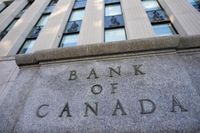The Bank of Canada maintained its key interest rate at 2.75% on Wednesday, April 16, 2025, marking a pause after seven consecutive decreases since June 2024. This decision comes amid a continuously evolving global trade war, particularly with the United States, which has introduced significant uncertainty into the Canadian economy. Governor Tiff Macklem stated that the disruptions from south of the border were central to the decision made by the bank.
In a prepared speech, Macklem noted, "The radical and protectionist shift in U.S. trade policy and its chaotic implementation have heightened uncertainty, disrupted financial markets, moderated global growth prospects, and raised inflation expectations." He added, "The future is not clearer. We still do not know what tariffs will be imposed, whether they will be reduced or increased, or how long they will last." This cautious approach reflects the bank's strategy of balancing inflation control with the need to stimulate economic growth.
As part of its monetary policy review, the Bank of Canada published two economic forecasts alongside its rate decision. The first forecast anticipates a rapid elimination of tariffs and threats, which would lead to limited economic damage. In this scenario, inflation is expected to drop to 1.5% for most of the year, primarily due to the removal of the carbon tax for consumers, before rising back to the central bank's target of 2%.
The second forecast, however, envisions a more prolonged global trade war that could plunge Canada into a one-year recession. This scenario assumes that the United States imposes tariffs of 12% on all Canadian products, a higher rate of 25% on vehicles and their parts, and a 25% tax on goods imported from other countries. In response, Canada would likely impose similar tariffs on selected American products.
According to this projection, Canada's real gross domestic product (GDP) would contract for four consecutive quarters, with an average decline of 1.2%. The report on monetary policy warns that American tariffs would permanently reduce potential output and living standards in Canada. Additionally, this scenario could lead to inflation exceeding 3% by 2026, complicating the Bank of Canada's efforts to stabilize the economy.
These two forecasts represent only a portion of the possible outcomes, with the central bank emphasizing the importance of monitoring the evolving situation. Early tariffs and threats have already undermined business and consumer confidence in Canada, with some manufacturers resorting to layoffs.
Inflation has slowed to 2.3% in March, partly due to lower gasoline prices and reduced demand for travel to the United States amid the ongoing trade war. The Bank of Canada has indicated that it will exercise caution in setting future rates, closely observing the reduction in demand for Canadian exports caused by tariffs, the weakening of business and consumer spending, and the speed at which new costs are passed on to customers.
Before the rate decision, markets were nearly evenly split between expectations of a hold and a cut in rates. This uncertainty reflects the complex interplay between the tariffs imposed by the U.S. and the Bank of Canada’s inflation control measures. Macklem reiterated the bank's commitment to managing inflation, stating, "We agreed to keep the key interest rate unchanged while the direction of tariffs and their effects become clearer."
The impact of the previous rate cuts has been felt particularly by those looking to enter the housing market or renew their mortgages. For each quarter-point decrease in the interest rate, holders of variable-rate mortgages can expect to pay about $15 less per $100,000 of mortgage loan. For instance, a $200,000 mortgage at a 5% interest rate would see payments drop from $1,169 to $1,140 at 4.75% and further down to $1,112 at 4.5%. This gradual reduction in rates has provided some relief to borrowers.
As the Bank of Canada navigates these turbulent waters, the interplay between domestic economic stability and international trade relations remains critical. The outcome of the current trade negotiations and the subsequent economic impacts will be pivotal in shaping the bank's future monetary policy decisions.
In conclusion, the Bank of Canada’s decision to maintain its interest rate at 2.75% reflects a cautious approach amid significant global trade uncertainties. As the situation evolves, the central bank remains committed to monitoring economic indicators and adjusting its policies accordingly to safeguard Canada’s economic health.






